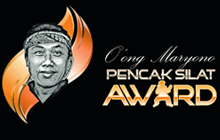After the review of pencak silat schools in the last issue, this article will focus on the development of pencak silat from a form of self-defence to a competition sport, showing how the different schools contributed or opposed such development.
Pencak silat contests in fact began long before pencak silat was officially recognised as a sport. Early last century, pencak silat contests were held to entertain the public at popular festivals. For instance, in East Java, pencak silat contests were annually organised by sugar factories before operations began. During these giling festivals, which lasted several days, two types of contests were held. Besides friendly contests, there were also competitive matches in which participants used all their technical skill and magical powers (dukdeng) to face and defeat their opponent, if necessary injuring or even killing them:
Like the pibu (competition arena) in China, there were no restrictions as to the age or sex of the participants. Fights were usually initiated by young novices. They would mount the pibu spinning and stepping gracefully and pointing both index fingers, indicating that this was a friendly match, involving removing the cap or stole of the opponent. Whoever managed to snatch the cap or stole of the other was the winner. As night fell, the music got louder, and the jagoan came down to fight. Usually these were free unarmed or armed contests. Those mounting the pibu spun round and round pointing one finger: a challenge for a free contest. If the person accepting the challenge was stronger and a greater fighter, and the challenger was frightened, he would have to kneel in respect. When this happened, the audience would laugh and shout. If they were equally matched, the free fight would go ahead. Usually the match began unarmed. But once one of the contestants had been attacked successfully, emotions ran high and the match turned into an armed contest. In fact, these contests ended at least in injury, and sometimes in death.[1]
These contests were prohibited by the Dutch Colonial administration in the 1930’s, but continued underground and can still be seen in Prajekan, Semboro and Asembagus in East Java.
However, real sharp weapons are no longer used, having been replaced by weapons made of bamboo. Pencak silat contests were also held at the night markets, with the difference that the matches were not competitive and there was no intention on the part of the contestants to injure the opponent. At the pasar malam, contests were only meant as entertainment to attract the attention of the public. Initially, the pesilat wore black shirts and could attack any part of the opponent’s body that was clothed with their chalked hands. The one who managed to put more white marks on the opponent’s body was declared the winner. Eventually, this system was considered unsatisfactory because it failed to express the real nature of pencak silat, and was replaced with the so-called ‘sistem penjung’ (system), in which the pesilat draped a scarf around his neck before the match began. The first to snatch his opponent’s scarf was the winner.
These precursors of modern-day competitions were crucial to the development of pencak silat olahraga, since they sought to determine a scoring system that could measure the ability of apesilat outside the context of self-defence. But before the 1950s most masters found it very hard to accept. On one side, masters of conservative schools resisted any form of pencak silat competition: if free contests were dismissed as dangerous and contrary to the humanistic principles of pencak silat, contests of speed were opposed because they involved performing pencak silat skills in public. On the other side, masters of moderate schools –who also view free fight matches as violent– would have been inclined to approve contests of speed was it not because of the unsatisfactory competition system, which considered only one aspect of pencak silat, namely speed, without regard for the strength and aesthetic quality of the pesilat’s movements.
The progressive schools that were in the process of advocating pencak silat olahraga heeded these criticisms. Perguruan inEast Java and Central Java –such as Setia Hati and its breakaway Pencak Sports Club, Perpi Harimurti, Phasadja and Persatuan Hati– struggled to improve the competition system and spread it across the country. In their opinion, pencak silat needed to be developed as a sport to prevent its vanishing from society. With the end of the war, the role of pencak silat as an instrument of self-defence had been lost. To try to find a new role more befitting to the age, pencak silat needed professional contests. Concerns about the safety of the pesilat did not need to be an issue, since pencak silat competitions would not be dangerous if the emotions and the power of movements were contained.
Initially, this optimism seemed justified. The first inter-master sports competition held at the Kalisari Stadium, in Semarang in 1957, pleased many pencak fans because it went ahead without accidents. But, sadly, other experimental matches ended in injuries, and even in death, because the competition system and scoring rules were very vague, and full body contact between thepesilat was still permitted. Consequently, pencak silat experienced difficulties in being accepted as a sports discipline. From the 1st National Sports Games (PON) in 1948 through the 7th in 1969, pencak silat was performed solely for demonstration purposes, with slight changes in the scoring system. In particular, from the 1st PON through the 4th PON, pencak silat was only demonstrated as performance, but at the 5th PON, held in Bandung on October 5-6, 1961, demonstrative pencak silat contests were held to determine the best pesilat, in ‘unarmed combat’ and ‘armed combat’. The jury, comprising representatives from the 12 regions the contestants hailed from, elected West Java as winner in both categories. More on this important development will be exposed in the next edition
[1] Interview with Soedar, Gagak Hitam master, on 28/10/1993 in the Nangkaan village, Bondowoso.
